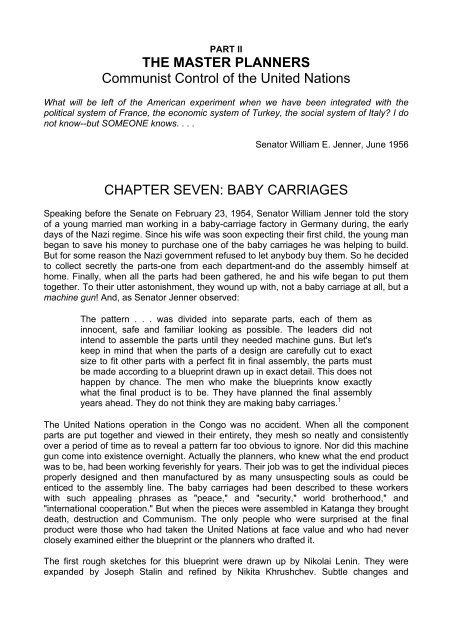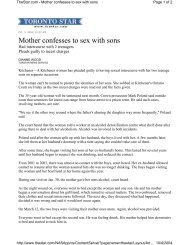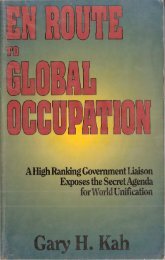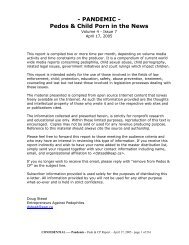G. Edward Griffin - The Fearful Master - PDF Archive
G. Edward Griffin - The Fearful Master - PDF Archive
G. Edward Griffin - The Fearful Master - PDF Archive
Create successful ePaper yourself
Turn your PDF publications into a flip-book with our unique Google optimized e-Paper software.
PART II<br />
THE MASTER PLANNERS<br />
Communist Control of the United Nations<br />
What will be left of the American experiment when we have been integrated with the<br />
political system of France, the economic system of Turkey, the social system of Italy? I do<br />
not know--but SOMEONE knows. . . .<br />
Senator William E. Jenner, June 1956<br />
CHAPTER SEVEN: BABY CARRIAGES<br />
Speaking before the Senate on February 23, 1954, Senator William Jenner told the story<br />
of a young married man working in a baby-carriage factory in Germany during, the early<br />
days of the Nazi regime. Since his wife was soon expecting their first child, the young man<br />
began to save his money to purchase one of the baby carriages he was helping to build.<br />
But for some reason the Nazi government refused to let anybody buy them. So he decided<br />
to collect secretly the parts-one from each department-and do the assembly himself at<br />
home. Finally, when all the parts had been gathered, he and his wife began to put them<br />
together. To their utter astonishment, they wound up with, not a baby carriage at all, but a<br />
machine gun! And, as Senator Jenner observed:<br />
<strong>The</strong> pattern . . . was divided into separate parts, each of them as<br />
innocent, safe and familiar looking as possible. <strong>The</strong> leaders did not<br />
intend to assemble the parts until they needed machine guns. But let's<br />
keep in mind that when the parts of a design are carefully cut to exact<br />
size to fit other parts with a perfect fit in final assembly, the parts must<br />
be made according to a blueprint drawn up in exact detail. This does not<br />
happen by chance. <strong>The</strong> men who make the blueprints know exactly<br />
what the final product is to be. <strong>The</strong>y have planned the final assembly<br />
years ahead. <strong>The</strong>y do not think they are making baby carriages. 1<br />
<strong>The</strong> United Nations operation in the Congo was no accident. When all the component<br />
parts are put together and viewed in their entirety, they mesh so neatly and consistently<br />
over a period of time as to reveal a pattern far too obvious to ignore. Nor did this machine<br />
gun come into existence overnight. Actually the planners, who knew what the end product<br />
was to be, had been working feverishly for years. <strong>The</strong>ir job was to get the individual pieces<br />
properly designed and then manufactured by as many unsuspecting souls as could be<br />
enticed to the assembly line. <strong>The</strong> baby carriages had been described to these workers<br />
with such appealing phrases as "peace," and "security," world brotherhood," and<br />
"international cooperation." But when the pieces were assembled in Katanga they brought<br />
death, destruction and Communism. <strong>The</strong> only people who were surprised at the final<br />
product were those who had taken the United Nations at face value and who had never<br />
closely examined either the blueprint or the planners who drafted it.<br />
<strong>The</strong> first rough sketches for this blueprint were drawn up by Nikolai Lenin. <strong>The</strong>y were<br />
expanded by Joseph Stalin and refined by Nikita Khrushchev. Subtle changes and



![Robert T McQuaid [rtmq@stn.net] Sent: Friday, October 29, 2004 12 ...](https://img.yumpu.com/51070071/1/190x245/robert-t-mcquaid-rtmqstnnet-sent-friday-october-29-2004-12-.jpg?quality=85)







